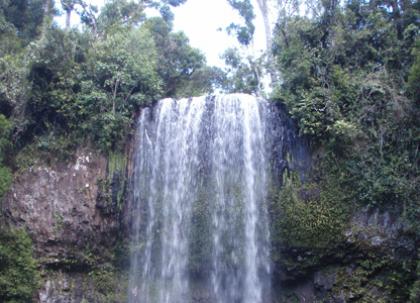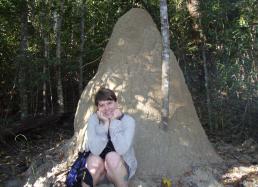5: In the Heart of the AWT
Wooroonooran National Park sits in the heart of the Australian Wet Tropics World Heritage Area. It includes Queensland’s two highest mountains, covered in lush rainforest habitats, as well as the Atherton Tablelands, which have several breathtaking waterfalls (see above photo.) All are home to many amazing animals, plants, and fungi.
Platypus, Victoria’s Riflebirds, and Southern Cassowaries are among some of the more unique animals in this forest. Victoria’s Riflebird (Ptiloris victoriae) belongs to the “bird of paradise” family, which is often known for the beautiful plumage of the males. This particular species is especially noted for its interesting courtship routines. Today, on our third day of camping in the rainforest, we awoke to the sounds of a nearby male singing in the hopes of attracting a mate.
Although the song is not all that noteworthy (pun intended), the dance of the male can be quite spectacular, and we were able to watch his routine for over an hour. Not only does the female come to witness the dance, but younger, inexperienced males also join the audience to learn techniques and prepare for when they reach sexual maturity. To see this amazing bird in action, check out this WorldBirds video. The dance we witnessed in Wooroonooran was just as impressive, and it was even more fantastic to watch out in the wild.
This site has truly been one of my favorites on the trip. Not only are the rainforests breathtaking, but the ant diversity is incredibly high. Although I won’t know how many species I've collected here until I get back to the Field Museum and can view them through a microscope, I’ve certainly collected close to 100 species of ants in 25 genera. Once I get these species home and have analyzed their DNA, I’ll be able to flesh out their family tree and learn more about how each species evolved and diversified during drying events. The branching of their family tree can even tell me when and where these events occurred.
For example, as I mentioned in my earlier blog, seeing dips in the past genetic diversity of a particular ant species tells me that they’re susceptible to drying events. And since I have cataloged where the ancestors of these species currently live, it becomes easier to predict where we’re likely to see the earliest effects of climatic drying—in other words, we can better pinpoint which parts of the rainforest will begin to shrink and break up into smaller patches by studying the genetic history of ants.
And speaking of ant diversity, one of the unique groups of ants in Australia are the “Jack Jumpers” or “Bulldog Ants” (as members of the genus Myrmecia spp. are often called). There are about 90 species of Myrmecia, all of which are found only in Australia, with the exception of one species found in New Caledonia. They're incredibly aggressive and have very painful stings. For some people, the venom in the sting can cause anaphylactic shock and even death, like honeybee stings (but don’t worry; I’ve avoided being stung so far.)
One thing I will say about these ants: they’re quite beautiful, with long jaws or mandibles and colors ranging from jet-black to shiny-red. And they're often rather large (by ant standards), ranging in size from 6 mm (0.24 inches) to 35 mm (1.4 inches). They also have big eyes and will watch you closely when you get near their nests. It’s a rather odd experience to have a nest of very aggressive ants following your every move in the rainforest.
However, while they can inflict a nasty sting, Jack Jumpers are a fantastic deterrent against termites (as are many ant species.) People are often surprised to learn that ants and termites aren’t related, and that they’re actually mortal enemies. In Australia, most people might pick ant neighbors if it meant keeping giant termite colonies at bay. Some of the most striking features of the Australian landscape are the giant termite mounds (found in both arid and rainforest habitats), which can be over 6 meters (almost 20 feet) in height!
Amazing feats of insect engineering, these mounds are composed of mud and saliva from the termites (see Photo #2 below.) The saliva/mud mixture is almost cement-like and not only protects the termites from predators like the ant- and termite-eating marsupial echidnas (anteaters), but also allows the termites to regulate their internal environment. These termite nests house several million termites and can take up to 50 years to build. Talk about a high-rise apartment complex!
In any case, the day has come to an end, and it’s time for a little relaxation. Although work is the highest priority, there’s always time for a little fun. This usually comes in the form of playing cards at night by the light of our headlamps, hiking a new trail without stopping to collect along the way, or splashing around in a nearby river or beach. But there's also fun to be had in the rainforest, and Jay could not help himself and had to try swinging on one of the rainforest vines like Tarzan (see Photo #3 below.) I can almost hear Tarzan’s call off in the distance….
More soon,
Dr. Corrie Moreau





